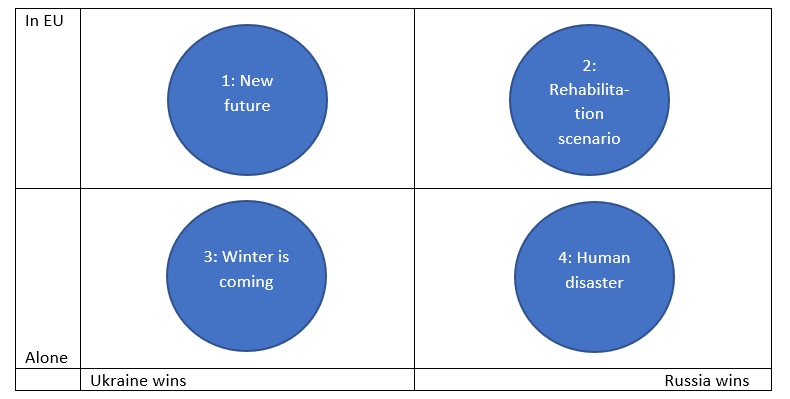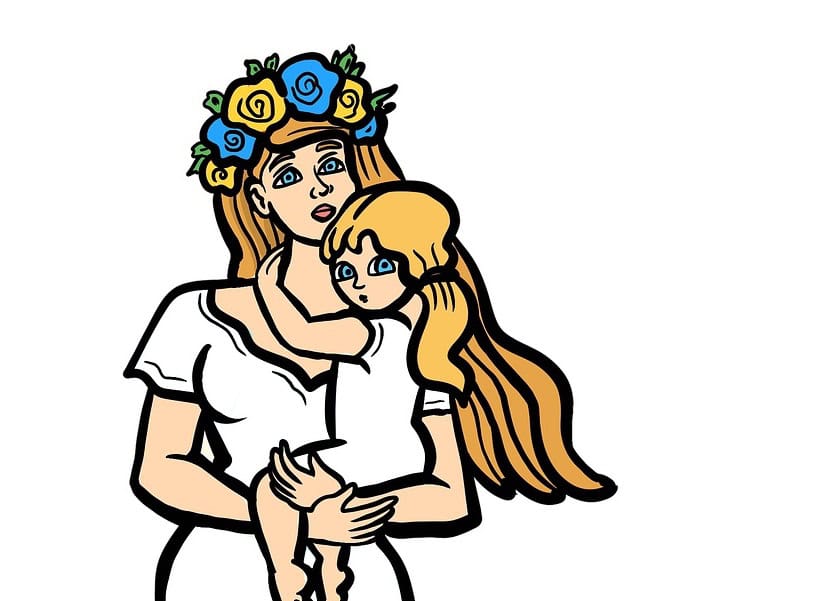Author: Manu Steens
In this article I write my own opinion, not that of any organization.
Contents
Context
Currently, President Zelensky claims that he wants peace, as he said to French-speaking countries, according to some social media. On the other hand, he first wants the Russians out of Ukraine and Crimea, according to the same social media. Currently, Putin is raising money from friendly nations to revive his war. He recently raised $13.6 billion in one day. In addition, the ‘partial’ mobilization of 300,000 reservists is a fact. A smaller part of them (more than 80,000 soldiers) would already have been deployed in Ukraine, the rest will receive training. He also bought missile-like drones from Iran and is trying to reduce the western part of Ukraine to ruins in terms of critical infrastructure.
What does this mean for the future? As in all wars, it is uncertain. We can put some things against each other and some extreme futures next to each other.
Two basic uncertainties
A first uncertainty is who wins the war. What does that mean, by the way, to win this war? For Ukraine, it is a matter of getting the Russian soldiers out, perhaps also from Crimea. For Russia, it may mean that it can recapture the lost territories up to the Dnipro in a stable way. But according to the Western media, the Russian soldiers are demotivated by the hard resistance and the lost areas. On the other hand, Russia, among other things, is shattering the energy supplies in Ukraine, which means a cold and icy winter and possibly death for millions. This can demotivate or motivate the Ukrainian soldiers. Recapturing the territories is not easy which makes it uncertain what will happen. That is a first axis: Ukraine wins versus Russia wins. (Only in military terms.)
A second axis is what happens to Ukraine after the war. I look at this separately from the question if it will become a NATO member. Will it be included in the EU? Can it embrace the Euro as the national currency? Will the EU co-invest in the reconstruction of the country or will it stand alone? Again, the last word has not yet been spoken.
Four possible futures
Then we can plot these two axes against each other as follows:

Overview of these four extreme scenarios, although the real future may lie somewhere in between.
1: New future
If the EU seizes the opportunity to help rebuild Ukraine, it will have to make huge investments. The first two things that will be needed are to rebuild electricity supplies and supply chain resources from the EU and the rest of the world to the shattered corners of Ukraine. Electricity is important because then the field hospitals, later the real hospitals will be able to work again, the companies can be restarted. Machines can then work. Computers are functioning again. Pumps are running and water supplies are functioning again. For supply chain: roadworks will not be missing, and only then will it be possible to rebuild intensively. If this is tackled big enough, it has some advantages. Like Germany after the Second World War, Ukraine can rise from the ashes and become a new economic engine of the EU in the long term. Hopefully, through an effective and efficient supply chain, a famine like the one in the Netherlands after WWII can be prevented. This, of course, will not erase the suffering, and a hatred of Russia may be permanent for the first few centuries. The accumulated war debts are partly repaid and partly cancelled.
As far as Russia is concerned, things are not going so well. Russia was not destroyed. It keeps its existing industry and lags behind financially due to the large debt burden it is now making in order to win the war. Future generations, who will have to pay this debt to the creditors, will not have it easy. It is possible that some of the future generations will flee the yoke of debt through emigration. And that can be done most easily where they integrate most easily at that moment. In fact, they, the future Russian children, are not to blame. They were also not taken into account in this war.
2: Rehabilitation scenario
Russia regains the territories up to the Dnipro and then stops his attack. NATO does not want a war with Russia and the EU only recognizes the remaining area as a possible member of the EU. Heavy cyberattacks happen from both sides. Zelensky is pushed to face the facts: without electricity, without equipment from the rest of the world, the war can only stop. The EU and the USA are helping and rebuilding the remaining area and, for the most part, stop working with Russia. Putin is going to get into the history books, but not in the way he wanted. Forces may emerge to overthrow Putin. Here, too, Russia has financial debts to repay. Ukraine is obliged to make peace in order to be able to export its grain safely overseas.
3: Winter is coming
Ukraine freezes. Reconstruction is very slow. The EU disapproves of membership. There are a lot of people who are dying from the cold and hunger. The refugees, especially widows with children, en masse, do not want to return to their homeland. Many try to go into hiding. The USA cancels part of the war debts in exchange for military bases in eastern Ukraine. The EU is groaning financially under the migrant pressure that has been going on for a long time. Racism against refugees is on the rise in Europe. Poland, in particular, thinks it is somewhat OK for the refugees to stay as long as they integrate and work. The reconstruction of Ukraine is progressing (too) slowly or stagnating due to the absence of an important part of the workforce: the female refugees. Ukraine becomes a failed state. Crime is rampant. It is uncertain whether Russia will not start a second war against weakened Ukraine.
4: Human disaster
Russia occupies a large part of the country up to the Dnipro. There is a migration of people, as far as is still necessary or possible: the ethnic Ukrainians are expelled, their place is taken by the ethnic Russians returning from Russia. Russia is committed to rebuilding the conquered area. The refugees want to give their children opportunities in their refuges, but the EU is putting them across the border. Due to a shortage of resources and medical supplies, diseases break out in Ukraine and people die. Because of extreme cold weather conditions and malnutrition cannibalism occurs here and there. Russia sabotages the reconstruction of western Ukraine. Ukraine cannot pay its war debts. The USA negotiates with the government to be able to build military bases in exchange for cancellation of (part of) the war debts. The EU offers minimal humanitarian aid, only the most necessary. Crime is growing. The country is collapsing. Also in this scenario, Ukraine becomes a ‘failed state’. The cold war with Russia of the past continues to flare up with violence. China offers aid to Ukraine in exchange for grain trade.
Conclusion
Whatever the outcome of the war, I think there is only the option that after the war Ukraine is not alone. It will be taken into NATO, maybe not, but it will be in the EU. This is her only chance of any recovery that is somewhat worthy of that name. It will not be easy for Russia after the war either. The young Russians, the future generations, are going to be a victim of this, regardless of who wins militarily. Much of the world will view them differently than before.
For both the EU and the USA, there is a major effort to be made after the war. This need is perhaps even greater than the investments they made during the war. The wounds that need to be taken care of, physically and psychologically, will never heal. Financially and economically, Ukraine can revive, if the investments after the war also entail an investment in new industry as in Germany after WWII.
At the expense of many children’s lives, sons and daughters of many mothers and fathers. On both sides.

